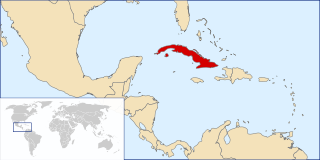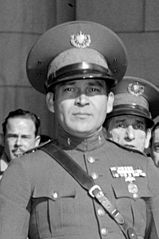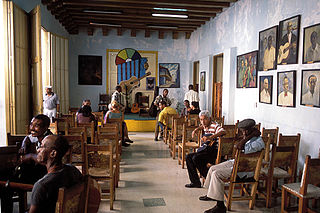
Exploring the history and experiences of mixed heritage persons and inter-racial relationships across the world

Exploring the history and experiences of mixed heritage persons and inter-racial relationships across the world
 The most populous island nation in the Caribbean, Cuba is home to over 11 million people, most of who, according to the 2002 census, consider themselves of be white. The 2002 census was the first one that allowed self-identification when prior to that over 60% were considered Mulatto, that is, of mixed European and African descent. Cuba has a large diaspora, the bulk of who reside in Miami in the United States. Most of these immigrants consider themselves as white Latin Americans.
The most populous island nation in the Caribbean, Cuba is home to over 11 million people, most of who, according to the 2002 census, consider themselves of be white. The 2002 census was the first one that allowed self-identification when prior to that over 60% were considered Mulatto, that is, of mixed European and African descent. Cuba has a large diaspora, the bulk of who reside in Miami in the United States. Most of these immigrants consider themselves as white Latin Americans.
Several genetic studies have revealed a much larger percentage of the population having some African ancestry than the nearly 3 million (23%) self-identified mulattos and the 1.7 million (10%) self-identified blacks in the country. This is consistent with the history of this island since it was claimed as a Spanish colony in 1492 by Christopher Columbus. Cuba was to remain a Spanish colony until the Spanish–American War which ended in 1898 when it became a USA colony.
The genetic studies do reveal the small contribution – about 4% - of the indigenous people that the Spanish found on the island to the modern Cuban’s genetic makeup. The island was inhabited by Guanajatabey, also known as the Ciboney, early settlers in the Caribbean who were displaced somewhat by the expanding warlike Taíno, sometimes also known as the Arawak, people. Within a century after European contact, the Guanajatabey were extinct throughout the Caribbean. It is sometimes stated that a Mestizo population of mixed Taíno and European descent, existed well into the 19th century in Cuba but today, both Amerindian and Mestizo ancestry appear nonexistent. Without a doubt, the old world infectious diseases contributed to the decline of the native numbers with a measles outbreak in 1529 killing over two thirds of those who had survived an earlier smallpox outbreak.
 Between the 18th and 20th century, Spanish immigration to Cuba soared. A large number of the Spanish immigrants came from the Canary Islands. The numbers were large enough to affect the dialect of Spanish spoken in Cuba, which is very similar to that spoken in the Canaries and to contribute North African – namely Berber – DNA to the Cuban genetic mix. Other Spanish immigrants hailed from Catalonia, Andalusia, Galicia, and Asturias.
Between the 18th and 20th century, Spanish immigration to Cuba soared. A large number of the Spanish immigrants came from the Canary Islands. The numbers were large enough to affect the dialect of Spanish spoken in Cuba, which is very similar to that spoken in the Canaries and to contribute North African – namely Berber – DNA to the Cuban genetic mix. Other Spanish immigrants hailed from Catalonia, Andalusia, Galicia, and Asturias.
The Spanish were the first Europeans to introduce African slaves in the Americas with the first Africans arrived in Hispaniola in 1501. Cuba received its first four slaves in 1513 but restrictive Spanish trade laws geared to protecting trade routes restricted greater participation in the Atlantic slave trade. Large influxes of slaves occurred when the British conquered Havana in 1762 during the Seven Years' War (1756 and 1763) and when French refugees of the Haitian Revolution (1791 to 1804) in nearby Saint-Domingue, now Haiti, brought their slaves. In 1817, more than half the population of Cuba were free-black or black African slaves. Between 1842 and 1873 some 221,000 slaves were landed on the island. Slavery was finally abolished in Cuba by a royal decree on 7th October 7 1886.
 Cuba gained formal independence from the U.S. in 1902 though the USA had enshrined in its constitution, its right to intervene in Cuban affairs. Since then Cuba has had only one socially defined non-white person as leader. In 1940, Fulgencio Batista who was of mixed European, African, Chinese and Amerindian descent and socially considered a Mulatto was democratically elected President in the elections of 1940 and served for four years. During his first term, Batista introduced many reforms but on his return to leadership in 1952, it appears that his sole interest was acceptance by the white Cuban elite which prompted his accumulation of personal riches. Batista’s corrupt rule was brought to a crashing end by the USA’s refusal to support him which allowed the Cuban revolutionaries, with Che Guevera and Fidel and Raúl Castro, to roll victoriously into Havana on 8th January 1959.
Cuba gained formal independence from the U.S. in 1902 though the USA had enshrined in its constitution, its right to intervene in Cuban affairs. Since then Cuba has had only one socially defined non-white person as leader. In 1940, Fulgencio Batista who was of mixed European, African, Chinese and Amerindian descent and socially considered a Mulatto was democratically elected President in the elections of 1940 and served for four years. During his first term, Batista introduced many reforms but on his return to leadership in 1952, it appears that his sole interest was acceptance by the white Cuban elite which prompted his accumulation of personal riches. Batista’s corrupt rule was brought to a crashing end by the USA’s refusal to support him which allowed the Cuban revolutionaries, with Che Guevera and Fidel and Raúl Castro, to roll victoriously into Havana on 8th January 1959.
 The revolutionaries rule led to Fidel Castro becoming the leader of Cuba and resulted in the emigration of hundreds of thousands of Cubans to the USA. Cuban Americans number just fewer than 2 million people and are the third largest Hispanic group in the USA.
The revolutionaries rule led to Fidel Castro becoming the leader of Cuba and resulted in the emigration of hundreds of thousands of Cubans to the USA. Cuban Americans number just fewer than 2 million people and are the third largest Hispanic group in the USA.
Fulgencio Batista’s dilemma in seeking acceptance by the higher social group is a symptom of an underlying issue with race which Cuban officialdom seeks to discount. However, like the rest of the Hispanic Caribbean and parts of Central and South America, Cuban non-white society is becoming more vocal about the injustices such as racism, colourism and classism that are sometimes used to disguise racism.
Links